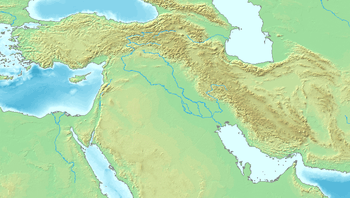Ilshu-rabi
Ilshu-rabi, also Ilšu-rabi (𒀭𒋢𒊏𒉈 Il-shu-rabi) was a ruler of Pashime around 2250 BCE. He was a vassal of the Akkadian Empire ruler Manishtushu.[3]
| Ilshu-rabi 𒀭𒋢𒊏𒉈 | |
|---|---|
| Governor of Pashime | |
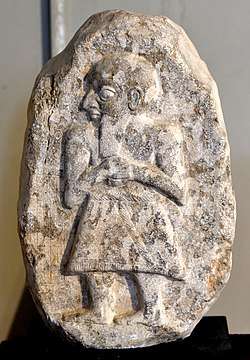 | |
| Reign | c. 2269-2255 BCE |
| Dynasty | Akkadian Governor of Pashime |
While Ilshu-rabi was in charge of Pashime, another Governor of Manistushu named Eshpum was in charge of Elam, in the city of Susa.[4]
Stele of Ilshu-rabi
A relief of Ilshu-rabi is known, which was discovered in Tell Abu Sheeja, ancient Pashime. The inscription on the stele reads:
"For the God Shuda, Ilsu-rabi of Pashime, the soldier, brought in this statue. May the one who erases the name (on this inscription) not find an heir; may he not acquire a name (for himself)
 Inscription on the Stele of Ilshu-rabi
Inscription on the Stele of Ilshu-rabi.jpg) The name "Ilshu-rabi" on his stele.
The name "Ilshu-rabi" on his stele.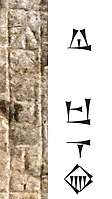 The name of Pashime (𒁀𒋛𒈨𒆠 ba-si-meKI) on the stele of Ilšu-rabi
The name of Pashime (𒁀𒋛𒈨𒆠 ba-si-meKI) on the stele of Ilšu-rabi
Manishtushu Obelisk
The name of Ilšu-rabi as Governor of Pashime also appears in the Manishtushu Obelisk inscription, in several mentions of his son Ipulum, who is said to be:
(𒌉) 𒀭𒋢𒊏𒉈 𒑐𒋼𒋛 𒁀𒋛𒈨𒆠
(dumu) il-su-ra-bi2 ensi2 ba-si-me{ki}
"(Son of) Ilshu-rabi, Governor of Pashime"
 "Ilšu-rabi, Governor of Pashime" appears in the Manishtushu Obelisk
"Ilšu-rabi, Governor of Pashime" appears in the Manishtushu Obelisk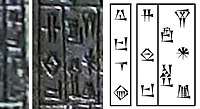 "Son of Ilshu-rabi the Governor / of Pashime" on the Manishtushu Obelisk (Columns 22 and 23, surface c).[8]
"Son of Ilshu-rabi the Governor / of Pashime" on the Manishtushu Obelisk (Columns 22 and 23, surface c).[8]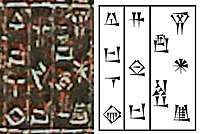 "Son of Ilshu-rabi, Governor of Pashime" on the Manishtushu Obelisk (Column 15, surface d).[9]
"Son of Ilshu-rabi, Governor of Pashime" on the Manishtushu Obelisk (Column 15, surface d).[9]
References
- "Tell Abu Sheeja/ Ancient Pashime" (PDF). Cite journal requires
|journal=(help) - Eppihimer, Melissa (2019). Exemplars of Kingship: Art, Tradition, and the Legacy of the Akkadians. Oxford University Press. p. 222, note 26. ISBN 978-0-19-090301-5.
- Álvarez-Mon, Javier (2020). The Art of Elam CA. 4200–525 BC. Routledge. p. 209. ISBN 978-1-000-03485-1.
- Potts, D. T. (1999). The Archaeology of Elam: Formation and Transformation of an Ancient Iranian State. Cambridge University Press. p. 106. ISBN 978-0-521-56496-0.
- Hussein, A. M.; Hamza, H. A.; Thaher, A. K.; Kadhum, S. J.; Hashem, M.; Taha, H. M.; Altaweel, M. R.; Studevent-Hickman, B. (2010). "Tell Abu Sheeja/Ancient Pašime: Report on the First Season of Excavations, 2007". Akkadica. pp. 47–103.
- Manishtushu Obelisk Column 15 Lines 15-16-17 d-su-ra-bi2 ensi2 ba-si-me{ki} "CDLI-Found Texts". cdli.ucla.edu.
- Eppihimer, Melissa (2019). Exemplars of Kingship: Art, Tradition, and the Legacy of the Akkadians. Oxford University Press. p. 222. ISBN 978-0-19-090301-5.
- "CDLI-Found Texts". cdli.ucla.edu.
- "CDLI-Found Texts". cdli.ucla.edu.
| Wikimedia Commons has media related to Ilshu-rabi. |
| Preceded by |
Akkadian Governor of Pashime 2250 BCE |
Succeeded by |
